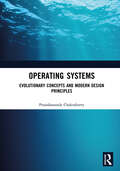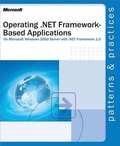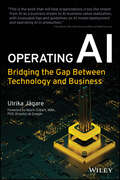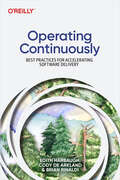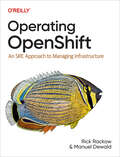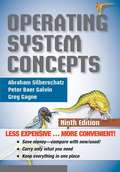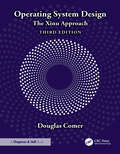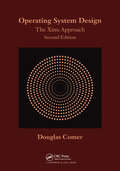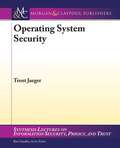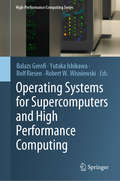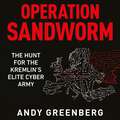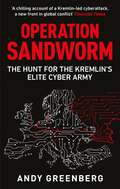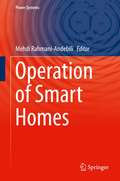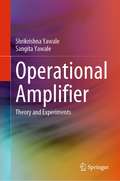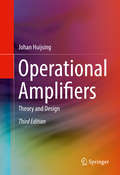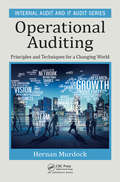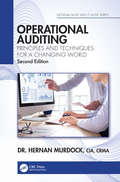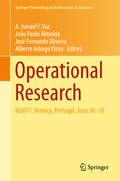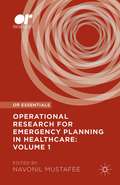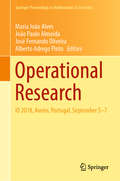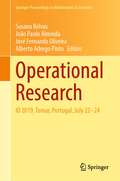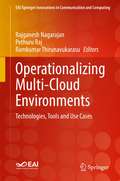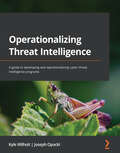- Table View
- List View
Operating Systems: Evolutionary Concepts and Modern Design Principles
by Pranabananda ChakrabortyThis text demystifies the subject of operating systems by using a simple step-by-step approach, from fundamentals to modern concepts of traditional uniprocessor operating systems, in addition to advanced operating systems on various multiple-processor platforms and also real-time operating systems (RTOSs). While giving insight into the generic operating systems of today, its primary objective is to integrate concepts, techniques, and case studies into cohesive chapters that provide a reasonable balance between theoretical design issues and practical implementation details. It addresses most of the issues that need to be resolved in the design and development of continuously evolving, rich, diversified modern operating systems and describes successful implementation approaches in the form of abstract models and algorithms. This book is primarily intended for use in undergraduate courses in any discipline and also for a substantial portion of postgraduate courses that include the subject of operating systems. It can also be used for self-study. Key Features • Exhaustive discussions on traditional uniprocessor-based generic operating systems with figures, tables, and also real-life implementations of Windows, UNIX, Linux, and to some extent Sun Solaris.• Separate chapter on security and protection: a grand challenge in the domain of today’s operating systems, describing many different issues, including implementation in modern operating systems like UNIX, Linux, and Windows.• Separate chapter on advanced operating systems detailing major design issues and salient features of multiple-processor-based operating systems, including distributed operating systems. Cluster architecture; a low-cost base substitute for true distributed systems is explained including its classification, merits, and drawbacks.• Separate chapter on real-time operating systems containing fundamental topics, useful concepts, and major issues, as well as a few different types of real-life implementations. • Online Support Material is provided to negotiate acute page constraint which is exclusively a part and parcel of the text delivered in this book containing the chapter-wise/topic-wise detail explanation with representative figures of many important areas for the completeness of the narratives.
Operating .NET Framework-based Applications
by Microsoft CorporationGet reliable, real-world answers to your questions about application deployment for Microsoft® .NET. This guide provides practical, prescriptive guidance for administrators monitoring and maintaining enterprise-level business applications based on the.NET Framework within hybrid data center environments. It also provides key information for developers designing and creating these .NET Framework-based applications. Focusing on three critical areas--security, monitoring and reporting, and sizing and capacity planning--the book recommends best solutions within each scenario. All PATTERNS & PRACTICES guides are reviewed and approved by Microsoft engineering teams, consultants, partners, and customers--delivering accurate, real-world information that's been technically validated and tested.
Operating AI: Bridging the Gap Between Technology and Business
by Ulrika JagareA holistic and real-world approach to operationalizing artificial intelligence in your company In Operating AI, Director of Technology and Architecture at Ericsson AB, Ulrika Jägare, delivers an eye-opening new discussion of how to introduce your organization to artificial intelligence by balancing data engineering, model development, and AI operations. You'll learn the importance of embracing an AI operational mindset to successfully operate AI and lead AI initiatives through the entire lifecycle, including key aspects of security, privacy, and data rights. In the book, you’ll also discover: How to reduce the risk of entering bias in our artificial intelligence solutions The importance of efficient and reproduceable data pipelines, including how to manage your company's data An operational perspective on the development of AI models using the MLOps (Machine Learning Operations) approach, including how to deploy, run and monitor models and ML pipelines in production, that generates value in the real world With a strong emphasis on deployment and operations of trustworthy and reliable AI solutions that operate well in the real world—and not just the lab—Operating AI is a must-read for business leaders looking for ways to operationalize an AI business model that actually makes money, from the concept phase to running in a live production environment.
Operating Continuously: Best Practices for Accelerating Software Delivery
by Brian Rinaldi Edith Harbaugh Cody De ArklandSoftware delivery doesn't stop with deployment. Modern teams rely on an emerging set of best practices post-deployment to continuously improve, release, and operate their software. With this practical guide, CTOs, software architects, and senior engineering leaders will learn how to apply these practices to their existing operations. Authors Edith Harbaugh, Cody De Arkland, and Brian Rinaldi provide actionable insights into setting up and maintaining a smooth operational process post-deployment. You'll learn new approaches to releasing software, controlling systems at runtime, and measuring the impact of change. This book helps you: Understand how modern development processes have moved beyond the DevOps infinity loop Understand the evolution of CI/CD, and the operational impacts of that change Use the tools and processes necessary to measure the impact of change on production systems Explore an emerging class of techniques to separate deployment from release Learn how to use canary launches and feature flags to release faster with less risk Use experimentation and impact analysis to drive data driven software improvements
Operating OpenShift: An SRE Approach to Managing Infrastructure
by Rick Rackow Manuel DewaldKubernetes has gained significant popularity over the past few years, with OpenShift as one of its most mature and prominent distributions. But while OpenShift provides several layers of abstraction over vanilla Kubernetes, this software can quickly become overwhelming because of itsrich feature set and functionality. This practical book helps you understand and manage OpenShift clusters from minimal deployment to large multicluster installations.Principal site reliability engineers Rick Rackow and Manuel Dewald, who worked together on Red Hat's managed OpenShift offering for years, provide valuable advice to help your teams operate OpenShift clusters efficiently. Designed for SREs, system administrators, DevOps engineers, andcloud architects, Operating OpenShift encourages consistent and easy container orchestration and helps reduce the effort of deploying a Kubernetes platform. You'll learn why OpenShift has become highly attractive to enterprises large and small.Learn OpenShift core concepts and deployment strategiesExplore multicluster OpenShift Container Platform deploymentsAdminister OpenShift clusters following best practicesLearn best practices for deploying workloads to OpenShiftMonitor OpenShift clusters through state-of-the-art conceptsBuild and deploy Kubernetes operators to automate administrative tasksConfigure OpenShift clusters using a GitOps approach
Operating System Concepts
by Abraham Silberschatz Greg Gagne Peter GalvinThis text is an unbound, binder-ready edition. Operating System Concepts, now in its ninth edition, continues to provide a solid theoretical foundation for understanding operating systems. The ninth edition has been thoroughly updated to include contemporary examples of how operating systems function. The text includes content to bridge the gap between concepts and actual implementations. End-of-chapter problems, exercises, review questions, and programming exercises help to further reinforce important concepts. A new Virtual Machine provides interactive exercises to help engage students with the material.
Operating System Design: The Xinu Approach
by Douglas ComerLauded for avoiding the typical vague, high-level survey approach found in many texts, earlier editions of this bestselling book removed the mystery by explaining the internal structure of an operating system in clear, readable prose. The third edition of Operating System Design: The Xinu Approach expands and extends the text to include new chapters on a pipe mechanism, multicore operating systems, and considerations of operating systems being used in unexpected ways.The text covers all major operating system components, including the key topics of scheduling and context switching, physical and virtual memory management, file systems, device drivers, device-independent I/O, Internet communication, and user interfaces. More important, the book follows a logical architecture that places each component in a multi-level hierarchy. It simplifies learning about operating systems by allowing a reader to understand one level at a time without needing forward references. It starts with a bare machine and builds the system level by level. In the end, a reader will appreciate how all the components of an operating system work together to form a unified, integrated platform that allows arbitrary application programs to run concurrently.The text uses a small, elegant system named Xinu as an example to illustrate the concepts and principles and make the discussion concrete. Because an operating system must deal with the underlying hardware, the text shows examples for the two basic computer architectural approaches used in the computer industry: CISC and RISC. Readers will see that most of the code remains identical across the two architectures, and they can easily compare the differences among the machine-dependent pieces, such as hardware initialization code, device interface code, and context switch code.Xinu code is freely available, and readers are strongly encouraged to download the system and experiment by making modifications or extensions. The Xinu web page, https://xinu.cs.purdue.edu, contains links to the code from the book as well as instructions on how to run Xinu on experimenter hardware boards. The page also provides links to a version that runs on the (free) VirtualBox hypervisor. A reader can install VirtualBox on their laptop or desktop, and then run Xinu without the need for additional hardware.
Operating System Design: The Xinu Approach, Second Edition
by Douglas ComerAvoiding the typical black box approach found in other operating system textbooks, this bestselling book explains how to build an operating system from the ground up. It removes the mystery from operating system design and consolidates the body of material into a systematic discipline. The text presents a hierarchical design paradigm that organizes major operating system components in an orderly, understandable manner. This second edition has been completely rewritten with updated code throughout and examples for two low-cost experimenter boards.
Operating Systems Security (Synthesis Lectures On Information Security, Privacy, And Trust Ser.)
by Trent Jaeger Ravi SandhuOperating systems provide the fundamental mechanisms for securing computer processing. Since the 1960s, operating systems designers have explored how to build "secure" operating systems - operating systems whose mechanisms protect the system against a motivated adversary. Recently, the importance of ensuring such security has become a mainstream issue for all operating systems. In this book, we examine past research that outlines the requirements for a secure operating system and research that implements example systems that aim for such requirements. For system designs that aimed to satisfy these requirements, we see that the complexity of software systems often results in implementation challenges that we are still exploring to this day. However, if a system design does not aim for achieving the secure operating system requirements, then its security features fail to protect the system in a myriad of ways. We also study systems that have been retrofit with secure operating system features after an initial deployment. In all cases, the conflict between function on one hand and security on the other leads to difficult choices and the potential for unwise compromises. From this book, we hope that systems designers and implementors will learn the requirements for operating systems that effectively enforce security and will better understand how to manage the balance between function and security.
Operating Systems for Supercomputers and High Performance Computing (High-Performance Computing Series #1)
by Balazs Gerofi Yutaka Ishikawa Rolf Riesen Robert W. WisniewskiFew works are as timely and critical to the advancement of high performance computing than is this new up-to-date treatise on leading-edge directions of operating systems. It is a first-hand product of many of the leaders in this rapidly evolving field and possibly the most comprehensive. This new and important book masterfully presents the major alternative concepts driving the future of operating system design for high performance computing. In particular, it describes the major advances of monolithic operating systems such as Linux and Unix that dominate the TOP500 list. It also presents the state of the art in lightweight kernels that exhibit high efficiency and scalability at the loss of generality. Finally, this work looks forward to possibly the most promising strategy of a hybrid structure combining full service functionality with lightweight kernel operation. With this, it is likely that this new work will find its way on the shelves of almost everyone who is in any way engaged in the multi-discipline of high performance computing.(From the foreword by Thomas Sterling)
Operation Sandworm: The Hunt for the Kremlin's Elite Cyber Army
by Andy Greenberg*This book is published in the US as Sandworm: A New Era of Cyberwar and the Hunt for the Kremlin's Most Dangerous Hackers. The text is unchanged for this edition, except for the addition of a new foreword.*'With the nuance of a reporter and the pace of a thriller writer, Andy Greenberg gives us a glimpse of the cyberwars of the future while at the same time placing his story in the long arc of Russian and Ukrainian history.' -Anne Applebaum, bestselling author of Twilight of Democracy'A chilling account of a Kremlin-led cyberattack, a new front in global conflict" -Financial TimesThe true story of the most devastating act of cyberwarfare in history and the desperate hunt to identify and track the elite Russian agents behind it.In 2014, the world witnessed the start of a mysterious series of cyberattacks. Targeting American utility companies, NATO, and electric grids in Eastern Europe, the strikes grew ever more brazen. They culminated in the summer of 2017, when the malware known as NotPetya was unleashed, penetrating, disrupting, and paralyzing some of the world's largest businesses. At the attack's epicenter in Ukraine, ATMs froze. The railway and postal systems shut down. Hospitals went dark. NotPetya spread around the world, inflicting an unprecedented ten billion dollars in damage - the largest, most destructive cyberattack the world had ever seen.This is the true story of the hunt to unmask Sandworm: the group of hackers behind the attacks working in service of Russia's military intelligence agency. Following the years-long, globe-spanning work of the detectives tracking them, Operation Sandworm also exposes the larger story of a new global arms race, and the geopolitical chaos it is unleashing on the world. A narrative full of twists and turns, it captures a chilling new reality: in a war without borders, all of us live on the frontline.
Operation Sandworm: The Hunt for the Kremlin's Elite Cyber Army
by Andy Greenberg*This book is published in the US as Sandworm: A New Era of Cyberwar and the Hunt for the Kremlin's Most Dangerous Hackers. The text is unchanged for this edition, except for the addition of a new foreword.*'With the nuance of a reporter and the pace of a thriller writer, Andy Greenberg gives us a glimpse of the cyberwars of the future while at the same time placing his story in the long arc of Russian and Ukrainian history.' -Anne Applebaum, bestselling author of Twilight of Democracy'A chilling account of a Kremlin-led cyberattack, a new front in global conflict" -Financial TimesThe true story of the most devastating act of cyberwarfare in history and the desperate hunt to identify and track the elite Russian agents behind it.In 2014, the world witnessed the start of a mysterious series of cyberattacks. Targeting American utility companies, NATO, and electric grids in Eastern Europe, the strikes grew ever more brazen. They culminated in the summer of 2017, when the malware known as NotPetya was unleashed, penetrating, disrupting, and paralyzing some of the world's largest businesses. At the attack's epicenter in Ukraine, ATMs froze. The railway and postal systems shut down. Hospitals went dark. NotPetya spread around the world, inflicting an unprecedented ten billion dollars in damage - the largest, most destructive cyberattack the world had ever seen.This is the true story of the hunt to unmask Sandworm: the group of hackers behind the attacks working in service of Russia's military intelligence agency. Following the years-long, globe-spanning work of the detectives tracking them, Operation Sandworm also exposes the larger story of a new global arms race, and the geopolitical chaos it is unleashing on the world. A narrative full of twists and turns, it captures a chilling new reality: in a war without borders, all of us live on the frontline.
Operation of Smart Homes (Power Systems)
by Mehdi Rahmani-AndebiliThis book presents the latest research advancements in the operation of smart homes. It comprises new operation techniques including cooperative distributed energy scheduling, framework to react to malicious cyberattacks, framework for demand-side management, and framework for the design of smart homes to support residents’ wellness as well as new optimization techniques such as stochastic model predictive control and multi-time scale optimization. In addition, the book analyzes 11,000 studies that have been indexed in scientific databases and categorizes them based on various data points, including the field and the subject of the research, the name of the institutions, and the nationality of the authors.Presents new operation techniques of smart homes;Introduces new optimization techniques for operation of smart homes;Analyses 11,000 studies and categorizes them based on different data points.
Operational Amplifier: Theory and Experiments
by Shrikrishna Yawale Sangita YawaleThis book covers several aspects of the operational amplifier and includes theoretical explanations with simplified expressions and derivations. The book is designed to serve as a textbook for courses offered to undergraduate and postgraduate students enrolled in electronics and communication engineering. The topics included are DC amplifier, AC/DC analysis of DC amplifier, relevant derivations, a block diagram of the operational amplifier, positive and negative feedbacks, amplitude modulator, current to voltage and voltage to current converters, DAC and ADC, integrator, differentiator, active filters, comparators, sinusoidal and non-sinusoidal waveform generators, phase lock loop (PLL), etc. This book contains two parts—sections A and B. Section A includes theory, methodology, circuit design and derivations. Section B explains the design and study of experiments for laboratory practice. Laboratory experiments enable students to perform a practical activity that demonstrates applications of the operational amplifier. A simplified description of the circuits, working principle and practical approach towards understanding the concept is a unique feature of this book. Simple methods and easy steps of the derivation and lucid presentation are some other traits of this book for readers that do not have any background information about electronics. This book is student-centric towards the basics of the operational amplifier and its applications. The detailed coverage and pedagogical tools make this an ideal textbook for students and researchers enrolled in senior undergraduate and beginning postgraduate electronics and communication engineering courses.
Operational Amplifiers
by Johan HuijsingOperational Amplifiers - Theory and Design, Second Edition presents a systematic circuit design of operational amplifiers. Containing state-of-the-art material as well as the essentials, the book is written to appeal to both the circuit designer and the system designer. It is shown that the topology of all operational amplifiers can be divided into nine main overall configurations. These configurations range from one gain stage up to four or more stages. Many famous designs are evaluated in depth. Additional chapters included are on systematic design of µV-offset operational amplifiers and precision instrumentation amplifiers by applying chopping, auto-zeroing, and dynamic element-matching techniques. Also, techniques for frequency compensation of amplifiers with high capacitive loads have been added. Operational Amplifiers - Theory and Design, Second Edition presents high-frequency compensation techniques to HF-stabilize all nine configurations. Special emphasis is placed on low-power low-voltage architectures with rail-to-rail input and output ranges. In addition to presenting characterization of operational amplifiers by macro models and error matrices, together with measurement techniques for their parameters it also develops the design of fully differential operational amplifiers and operational floating amplifiers. Operational Amplifiers - Theory and Design, Second Edition is carefully structured and enriched by numerous figures, problems and simulation exercises and is ideal for the purpose of self-study and self-evaluation.
Operational Auditing: Principles and Techniques for a Changing World (Internal Audit and IT Audit #11)
by Hernan MurdockInternal auditors are expected to perform risk-based audits, but do so partially because they focus on financial and compliance risks at the expense of operational, strategic and technological ones. This limits their ability to evaluate critical risks and processes. This book merges traditional internal audit concepts and practices with contemporary quality control methodologies, tips, tools and techniques. It helps internal auditors perform value-added operational audits that result in meaningful findings and useful recommendations to help organizations meet objectives and improve the perception of internal auditors as high-value contributors, appropriate change agents and trusted advisors.
Operational Auditing: Principles and Techniques for a Changing World (Internal Audit and IT Audit #11)
by Hernan MurdockOperational Auditing: Principles and Techniques for a Changing World, 2nd edition, explains the proven approaches and essential procedures to perform risk-based operational audits. It shows how to effectively evaluate the relevant dynamics associated with programs and processes, including operational, strategic, technological, financial and compliance objectives and risks. This book merges traditional internal audit concepts and practices with contemporary quality control methodologies, tips, tools and techniques. It explains how internal auditors can perform operational audits that result in meaningful findings and useful recommendations to help organizations meet objectives and improve the perception of internal auditors as high-value contributors, appropriate change agents and trusted advisors. The 2nd edition introduces or expands the previous coverage of: • Control self-assessments. • The 7 Es framework for operational quality. • Linkages to ISO 9000. • Flowcharting techniques and value-stream analysis • Continuous monitoring. • The use of Key Performance Indicators (KPIs) and Key Risk Indicators (KRIs). • Robotic process automation (RPA), artificial intelligence (AI) and machine learning (ML); and • Adds a new chapter that will examine the role of organizational structure and its impact on effective communications, task allocation, coordination, and operational resiliency to more effectively respond to market demands.
Operational Images: From the Visual to the Invisual
by Jussi ParikkaAn in-depth look into the transformation of visual culture and digital aesthetics First introduced by the German filmmaker Harun Farocki, the term operational images defines the expanding field of machine vision. In this study, media theorist Jussi Parikka develops Farocki&’s initial concept by considering the extent to which operational images have pervaded today&’s visual culture, outlining how data technologies continue to develop and disrupt our understanding of images beyond representation.Charting the ways that operational images have been employed throughout a variety of fields and historical epochs, Parikka details their many roles as technologies of analysis, capture, measurement, diagramming, laboring, (machine) learning, identification, tracking, and destruction. He demonstrates how, though inextricable from issues of power and control, operational images extend their reach far beyond militaristic and colonial violence and into the realms of artificial intelligence, data, and numerous aspects of art, media, and everyday visual culture.Serving as an extensive guide to a key concept in contemporary art, design, and media theory, Operational Images explores the implications of machine vision and the limits of human agency. Through a wealth of case studies highlighting the areas where imagery and data intersect, this book gives us unprecedented insight into the ever-evolving world of posthuman visuality. Cover alt text: Satellite photo on which white title words appear in yellow boxes. Yellow lines connect the boxes.
Operational Research
by João Paulo Almeida José Fernando Oliveira Alberto Adrego Pinto A. Ismael VazThis proceedings book presents selected contributions from the XVIII Congress of APDIO (the Portuguese Association of Operational Research) held in Valença on June 28–30, 2017. Prepared by leading Portuguese and international researchers in the field of operations research, it covers a wide range of complex real-world applications of operations research methods using recent theoretical techniques, in order to narrow the gap between academic research and practical applications. Of particular interest are the applications of, nonlinear and mixed-integer programming, data envelopment analysis, clustering techniques, hybrid heuristics, supply chain management, and lot sizing and job scheduling problems. In most chapters, the problems, methods and methodologies described are complemented by supporting figures, tables and algorithms.The XVIII Congress of APDIO marked the 18th installment of the regular biannual meetings of APDIO – the Portuguese Association of Operational Research. The meetings bring together researchers, scholars and practitioners, as well as MSc and PhD students, working in the field of operations research to present and discuss their latest works. The main theme of the latest meeting was Operational Research Pro Bono. Given the breadth of topics covered, the book offers a valuable resource for all researchers, students and practitioners interested in the latest trends in this field.
Operational Research for Emergency Planning in Healthcare: Volume 1 (OR Essentials)
by Navonil MustafeeThis book presents a collection of studies that have applied analytical methods to improve preparedness, planning, and a faster response to A&E and public health emergencies like epidemic and disease outbreak. It explores the application of quantitative Operational Research techniques such as Mathematical Modelling and Optimization, Maximum Likelihood Estimation, Multiple-Criteria Decision Analysis, Discrete-event Simulation, Data Mining, and Bayesian Decision Models. These techniques have been used for better management of emergency care, including first responders, ambulance services, A&E departments, and mass immunisation centres. This volume focuses on planning at the operational level whereas volume 2 focuses mainly on planning at the strategic level. The OR Essentials series presents a unique cross-section of high quality research work fundamental to understanding contemporary issues and research across a range of Operational Research (OR) topics. It brings together some of the best research papers from the highly respected journals of the Operational Research Society, also published by Palgrave Macmillan.
Operational Research for Emergency Planning in Healthcare: Volume 2 (OR Essentials)
by Maysaa Husam JaberThis book presents a selection of studies that have applied Operational Research methods to improve emergency planning in healthcare, to include both A&E and public health emergencies like epidemic and natural disasters. The studies have delved into qualitative Operational Research like Problem Structuring, Critical Systems Thinking, Soft Systems Methodology, and Qualitative System Dynamics, and also quantitative techniques such as Monte Carlo Simulation, Discrete-event Simulation, and System Dynamics. These techniques have been applied for review and assessment of emergency services, for policy formulation and for facilitating broader public engagement in emergency preparedness and response. Furthermore, this book presents rigorous reviews on the applications of Operational Research in the wider healthcare context. This volume focuses mainly on emergency planning at the strategic level, whereas volume 1 focuses on planning at the operational level. The OR Essentials series presents a unique cross-section of high quality research work fundamental to understanding contemporary issues and research across a range of Operational Research (OR) topics. It brings together some of the best research papers from the highly respected journals of the Operational Research Society, also published by Palgrave Macmillan.
Operational Research: IO 2018, Aveiro, Portugal, September 5-7 (Springer Proceedings in Mathematics & Statistics #278)
by Maria João Alves João Paulo Almeida José Fernando Oliveira Alberto Adrego PintoThis book gathers selected contributions by top Portuguese and international researchers in the field of Operations Research, presented at the 19th Congress of APDIO (Portuguese Association of Operational Research). The papers address a broad range of complex real-world problems, which are approached using recent theoretical techniques. Of particular interest are the applications of e.g. linear, nonlinear and mixed-integer programming, multiobjective optimization, metaheuristics and hybrid heuristics, multicriteria decision analysis, data envelopment analysis, clustering techniques and decision support systems, in such varied contexts as: supply chain management, scheduling problems, production management, logistics, energy, finance and healthcare. This conference, organized by APDIO and held in Aveiro, Portugal in September 2018, offered an ideal opportunity to discuss the latest developments in this field and to build new bridges between academic researchers and practitioners. Summarizing the outcomes, this book offers a valuable tool for all researchers, students and practitioners who wish to learn about the latest trends in this field.
Operational Research: IO 2019, Tomar, Portugal, July 22–24 (Springer Proceedings in Mathematics & Statistics #374)
by João Paulo Almeida José Fernando Oliveira Alberto Adrego Pinto Susana RelvasThis book addresses complex real-world problems with recent techniques. It comprises selected papers from the XX. congress APDIO held in Tomar, Portugal, in July 2019. The subject of the book is the application of operational research methodologies and techniques to address complex real problems. Readers will find interesting results and applications of operational research methods and techniques in the wide variety of the addressed problems. Of particular interest are the applications of, among others, linear, nonlinear and mixed-integer programing, multiobjective optimization, metaheuristics and hybrid heuristics, multicriteria decision analysis, data envelopment analysis, clustering techniques and decision support systems, in different areas such as supply chain management, scheduling problems, production management, logistics, energy, telecommunications and finance and health. In most chapters of the book, the described problems, methods and methodologies will be illustrated by auxiliary figures and tables, as well as algorithms. The main benefit of this book is to present the latest trends in operational research methods and methodologies by top Portuguese and international researchers. The book will present a wide scope of complex real-world applications addressed by recent theoretical techniques that aim to narrow the gap between academic researchers and practitioners.
Operationalizing Multi-Cloud Environments: Technologies, Tools and Use Cases (EAI/Springer Innovations in Communication and Computing)
by Pethuru Raj Rajganesh Nagarajan Ramkumar ThirunavukarasuThis book discusses various aspects of the multi-cloud paradigm. The initial portion of the book focuses on the motivations for the industry to embrace a multi-cloud option and the distinct business, technology, and user cases of multi-cloud implementations. The middle part of the book explains the challenges of setting up and sustaining multi-cloud environments. The latter portion focuses on the next-generation technologies and tools along with multi-cloud platforms, processes, patterns, and practices. The final segment of the book is dedicated for cloud brokerage systems. The various traits and tenets of cloud brokerage services especially for accomplishing cloud intermediation, integration, orchestration, governance, security, management, configuration, etc. are explained in detail. The book also clearly articulates how to have intelligent brokers.
Operationalizing Threat Intelligence: A guide to developing and operationalizing cyber threat intelligence programs
by Kyle Wilhoit Joseph OpackiLearn cyber threat intelligence fundamentals to implement and operationalize an organizational intelligence programKey FeaturesDevelop and implement a threat intelligence program from scratchDiscover techniques to perform cyber threat intelligence, collection, and analysis using open-source toolsLeverage a combination of theory and practice that will help you prepare a solid foundation for operationalizing threat intelligence programsBook DescriptionWe're living in an era where cyber threat intelligence is becoming more important. Cyber threat intelligence routinely informs tactical and strategic decision-making throughout organizational operations. However, finding the right resources on the fundamentals of operationalizing a threat intelligence function can be challenging, and that's where this book helps. In Operationalizing Threat Intelligence, you'll explore cyber threat intelligence in five fundamental areas: defining threat intelligence, developing threat intelligence, collecting threat intelligence, enrichment and analysis, and finally production of threat intelligence. You'll start by finding out what threat intelligence is and where it can be applied. Next, you'll discover techniques for performing cyber threat intelligence collection and analysis using open source tools. The book also examines commonly used frameworks and policies as well as fundamental operational security concepts. Later, you'll focus on enriching and analyzing threat intelligence through pivoting and threat hunting. Finally, you'll examine detailed mechanisms for the production of intelligence. By the end of this book, you'll be equipped with the right tools and understand what it takes to operationalize your own threat intelligence function, from collection to production.What you will learnDiscover types of threat actors and their common tactics and techniquesUnderstand the core tenets of cyber threat intelligenceDiscover cyber threat intelligence policies, procedures, and frameworksExplore the fundamentals relating to collecting cyber threat intelligenceUnderstand fundamentals about threat intelligence enrichment and analysisUnderstand what threat hunting and pivoting are, along with examplesFocus on putting threat intelligence into productionExplore techniques for performing threat analysis, pivoting, and huntingWho this book is forThis book is for cybersecurity professionals, security analysts, security enthusiasts, and anyone who is just getting started and looking to explore threat intelligence in more detail. Those working in different security roles will also be able to explore threat intelligence with the help of this security book.
